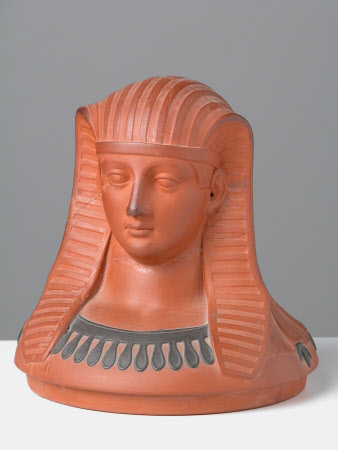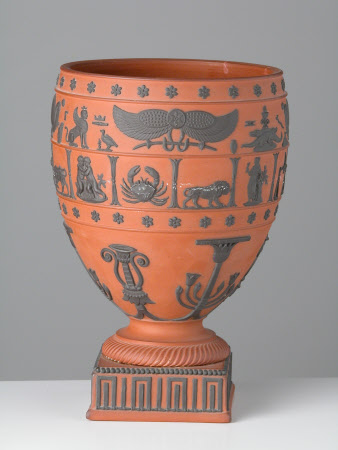Jar and cover
Wedgwood
Category
Ceramics
Date
c. 1798 - 1810
Materials
Ceramics, Rosso Antico
Measurements
270 mm (Height)
Place of origin
Stoke-on-Trent
Order this imageCollection
Stourhead, Wiltshire
NT 730562
Summary
Jar and cover, Rosso Antico (red stoneware with black applied relief decoration), Wedgwood, Stoke-on-Trent, Staffordshire, England, circa 1798-1810. The cover modelled as a bust wearing an Egyptian headdress or 'nemes' and the jar with friezes of ornamental hieroglyphics and the signs of the zodiac. Impressed 'Wedgwood.' The signs of the zodiac were drawn by Mary Landré in 1774 and modelled by William Hackwood. The design of the jar was loosely based on Bernard de Montfaucon's 'L'antiquité expliquée' (1719-1724), Vol. II, Part 2. Called a 'canopic jar,' the form is based on the human-headed jars associated with Osiris-Hydreios, the watery form of the God of death and resurrection, who had a shrine in Canopus, in the Nile Delta near Alexandria. The cults of Isis and Osiris were popular all over the Roman Empire, and a large number of these jars originate from the environs of Rome. Eighteenth-century Europeans would have been more visually familiar with the water jars of Osiris-Hydreios than the funerary jars which would only have been accessible to those who took the much harder journey into Egypt at this time, but which have come to be associated with the term 'canopic.'
Provenance
Probably acquired by Sir Richard Colt Hoare, 2nd Baronet (1758-1838). Listed in the 'Inventory of Furniture, Bedding, Carpets, China, Plate, Pictures, Curios, and other effects on the premises of the mansion,' January 1908, in the Cabinet Room, as ‘One 11" Wedgwood Sphinx jar and cover.' Bequeathed by Sir Henry Hugh Arthur Hoare, 6th Bt (1865 – 1947), 1946.
Makers and roles
Wedgwood , manufacturer William Hackwood, modeller

